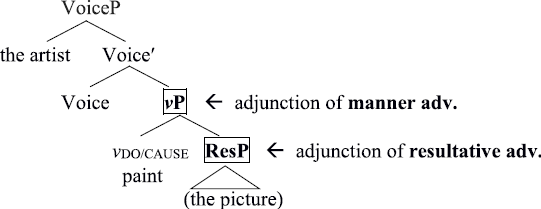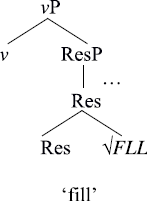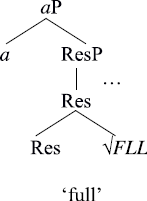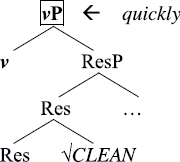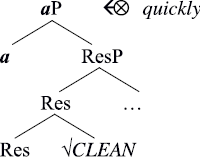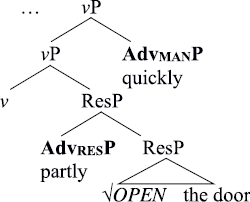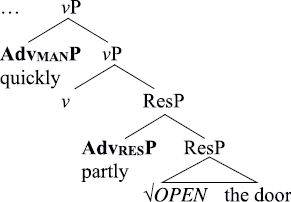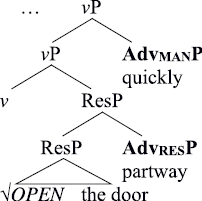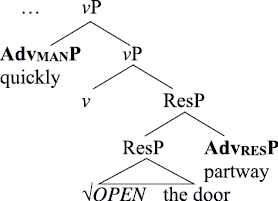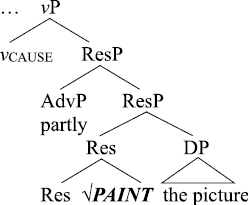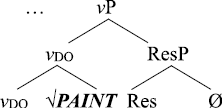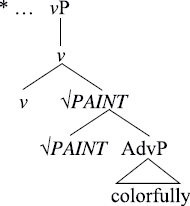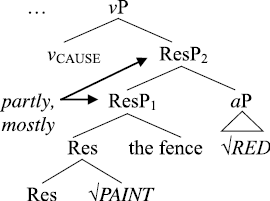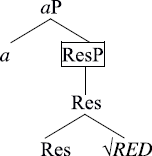1 Introduction
This study scrutinizes the syntactic properties of a group of adverbs expressing the outcome of a verbal event and attempts to answer the questions they raise for the theory of grammar. The adverbs in (1) illustrate this. We call these “resultative” adverbs, following Geuder (2000):
- (1)
- a.
- The artist painted the picture colorfully.
- b.
- The chef chopped the onion finely.
- c.
- Jeff sliced the bread thinly.
Considering the meanings of the examples in (1), the adverbs at issue are pertinent to the resultant state of events named by the verb. As such, they are qualitatively distinct from manner adverbs, such as quickly and loudly. Within the earlier framework of the Minimalist Program, Bowers (1993) and Harley (1995) analyzed the distribution of adverbs of the type in (1). However, they thematically grouped them with manner adverbs. Consequently, some of their fundamental characteristics remain unexplored. More recently, Levinson (2007; 2010) and Folli & Harley (2020) employed resultative adverbs as part of their respective inquiry into the structure of “pseudo-resultatives” (e.g., Mary braided her hair tight) and “created result” (e.g., Mary carved the wood into a doll) constructions. Neither is directly concerned with how and where resultative adverbs participate in the structure.
The topic of resultative adverbs is more actively investigated in the realm of semantics (Dik 1975; Eckardt 1998; 2003; Geuder 2000; Schäfer 2005; Piñón 2008, among others). As it is unclear which syntactic constituent these adverbs modify, linguists have focused on formalizing these phenomena using event-semantic tools. For example, Geuder (2000) proposed that resultative adverbs are understood in association with the individual that becomes salient as a result of the verbal event and that this individual has no syntactic presence.
Nevertheless, the behaviors of resultative adverbs pose a series of significant questions regarding the composition of verb phrases in modern syntactic theory:
Q1: Resultative adverbs are allowed in some activity verb phrases in addition to accomplishment events (Vendler 1967). At which syntactic level(s) then does the resultative adverbial modification take place and are the aspectual properties of the verb encoded?
Q2: A related group of adverbs called “measure” adverbs (Tenny 2000) exhibit structural properties similar to, yet distinct from, resultative adverbs. How can one adequately explain the commonalities and contrasts between these two adverbial groups?
Q3: Pursuit of the first two inquiries raises a third question: at which point in the syntactic derivation are the verbal roots at issue introduced?
This study aims to provide answers to these questions. In this paper, we argue that the syntactic head that licenses resultative adverbial modification—Res(ult)—and the one that marks the aspectual information of the overall verb phrase—v—must be separated (Answer to Q1). We present various arguments for the dissociation of the heads Res and v. This includes distributional differences between resultative and manner adverbs, traits of adverbs that are ambiguous in expressing manner and result, and modification facts of certain roots that yield both verbs and adjectives.
Thereafter, we turn to our second objective of accommodating another set of adverbs that denote results. We demonstrate that measure adverbs, like resultative adverbs, are modifiers of the Result Phrase (ResP). In doing so, we show that though both resultative and measure adverbs are adjoined to ResP, the latter group detects the presence of “result roots” (Rappaport Hovav & Levin 2010; Levin & Rappaport Hovav 2013) (Answer to Q2). These roots start participating early in the derivation by head-adjoining to Res. Result roots differ from manner roots, which are head-adjoined to the verbalizing v head (Answer to Q3).
The remainder of this paper is structured as follows. We begin section 2 by observing the appearance of resultative adverbials within a seemingly incompatible event type (i.e., activity). In section 3, we present our analysis in which resultative adverbs are licensed at ResP, whereas the verbal aspect is expressed by the verbalizing v. In section 4, we present three pieces of independent support for the proposed structure. In section 5, we extend our analysis to explain the behaviors of measure adverbs (Tenny 2000). In section 6, we revisit the notion of result and manner roots, updating the preliminary structure proposed in section 3. Based on the conclusions thus far, we develop a pair of diagnostics that detect the presence of ResP and result roots. In section 7, we examine several alternative hypotheses and point out their issues. In section 8, we discuss a theoretical implication. Section 9 concludes the paper.
2 Resultative adverbs within activity
Geuder (2000) emphasizes that resultative adverbs do not denote a resultant state by themselves. Instead, they modify a result predicate already expressed by another element in the sentence. He clarifies this point by contrasting resultative adverbs (2a) with resultative adjectives such as (2b). The adjective flat in (2b) describes the result of a hammering event. In contrast, in (2a), the result is open. The adverb wide serves to detail the open state. In other words, the resultative adverb wide is a modifier, rather than the resultant state itself. This is unlike resultative adjectives such as flat in (2a), which are the resultant states themselves.12
- (2)
- a.
- I opened the door wide.
- b.
- He hammered the metal flat. (Geuder 2000: 69–70)
The idea that resultative adverbs are modifiers of results readily explains their behaviors in accomplishment events (Vendler 1967; Dowty 1979) such as (3). The verb phrase depicts a telic event that terminates when the picture, the incremental theme, is created, as in (4a). Thus, what is understood to be colorful in (4b) and (3) is the picture, which is produced as a result of painting.
- (3)
- The artist painted the picture colorfully.
- (4)
- a.
- The artist painted the picture in/#for two hours.
- b.
- The artist painted the picture colorfully in/#for two hours.
However, the patterns of resultative adverbs co-occurring with the activity counterparts of (3)–(4), as in (5)–(6), do not directly follow:
- (5)
- The artist painted colorfully.
- (6)
- a.
- The artist painted for/#in two hours.
- b.
- The artist painted colorfully for/#in two hours.
The examples in (5)–(6) show that colorfully can appear with an activity verb phrase. With no object to mark the termination of the event, paint as an intransitive verb expresses an activity, as demonstrated in (6a). The activity verb class describes a process with no end point. By hypothesis then, activity VPs seem to lack a result component.
If resultative adverbs are modifiers of results, as argued by Geuder (2000), but activity VPs lack results, the patterns in (5)–(6) call for an explanation. With the simplest assumption that structural results entail an end point, either the resultative adverb in (5) should be ruled out or adding the resultative adverb in (6b) should coerce an accomplishment interpretation, allowing for the in-PP instead of the for-PP. Neither appears to be the case.
Resultative adverbs can modify a number of lexical verbs that construct an activity event in addition to an accomplishment event.
- (7)
- a.
- Carrie wrote illegibly for/#in two hours.
- b.
- Sylvia cooked exquisitely for/#in two hours.
- c.
- Julie knitted intricately for/#in two hours.
- d.
- The secretary transcribed messily for/#in two hours.
However, as a reviewer points out, not all activity verbs can co-occur with resultative adverbs. The verbs in (8) resist resultative adverbial modification. Note that the verbs in (8) pattern with paintvi in (6a) in that they appear with a for-PP, not with an in-PP, as in (9). In this vein, the unacceptability of (8) is usually expected for a verb phrase with no result, in contrast to (5) and (7).
- (8)
- a.
- *The smith pounded thinly/finely.
- b.
- *Mary scrubbed cleanly.
- c.
- *The player kicked flat(ly).
- (9)
- a.
- The smith pounded for/#in two hours.
- b.
- Mary scrubbed for/#in two hours.
- c.
- The player kicked for/#in two hours.
An immediate question is: What is the key property that aligns a subclass of activity verbs, such as (5) and (7), with accomplishment verbs and simultaneously separates them from the verbs in (8), such that the former licenses a resultative adverb, whereas the latter does not? In the next section, we present a syntactic solution to this question. To wit, we propose to dissociate the syntactic head—Res(ult)—to which resultative adverbs are attached from the layer responsible for marking aspectual information. As we will show in detail in sections 4–5, the postulation of an independent Res head offers substantial empirical benefits.
3 Proposal: dissociating result from aspect
To recapitulate, the observation that certain activity verbs can appear with resultative adverbs raises a question about the two seemingly incompatible theses below:
- (10)
- a.
- Resultative adverbs are modifiers of a result (Geuder 2000).
- b.
- Activity VPs describe a process with no end point (Vendler 1967; Dowty 1979).
Before we present our account of (10), we discuss the theoretical assumptions adopted in this study. We take advantage of the apparatus offered by Distributed Morphology (DM; Halle & Marantz 1993; Marantz 1997; Arad 2005). The premises of relevance are as follows. First, in DM, roots enter derivation with their syntactic category undetermined. These category-neutral roots are categorized by a functional head such as v(erbalizer), a(djectivizer), n(ominalizer), and so forth. Second, we follow Levinson (2007; 2010) and Folli & Harley (2020) in assuming that roots can be added to the structure via adjunction. Finally, we assume that the external argument is introduced by Voice (Kratzer 1996; Pylkkänen 2002; 2008; Cuervo 2003; Alexiadou et al. 2006; Harley 2013; among others).
Returning to the question raised about (10), we argue that it receives a proper answer under the elaborate syntactic composition of the verb phrase. Specifically, we tease apart (i) the syntactic locus for resultative adverbial modification and (ii) the layer where aspectual information is encoded. We argue that the syntactic head licensing the resultative adverbial adjunction is Res(ult) (Ramchand 2008; Folli & Harley 2020). We highlight two hallmarks of Res. First, the Res head is present in the syntactic representation before the root is categorized as a verb by v (Folli & Harley 2020). Second, we propose to extend the original notion of Res (Ramchand 2008), such that though Res introduces a state resulting from the event described by the verb, it does not impose an end point on it. Consequently, Res can introduce various stages of a resulting state, including implicit results.
Meanwhile, we propose that the head responsible for encoding the verbal aspect is v. Since Harley’s (1995) pioneering research, the idea that the functional head v is subcategorized into a certain set of different “flavors”—do, cause, be, become—has been widely pursued (Harley & Noyer 2000; Cuervo 2003; Folli & Harley 2005; 2007; Harley 2009). Partially adopting the concept detailed in Harley (2009), we implement vcause for events whose verbal aspect depicts a measurable change in state and vdo for those whose aspect does not. For this purpose, an activity structure like (6a) employs vdo, whereas an accomplishment like (4a) takes vcause. In this way, we can make a distinction between the two events independent of the presence of a Res head in the structure.
Combining the ingredients introduced so far, we propose the structure (11) for the accomplishment VP in (3):3
- (11)
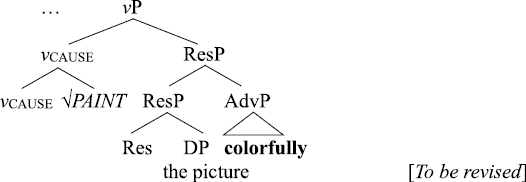
- ‘The artist painted the picture colorfully.’
Here, (11) contains a ResP below the verbalizing level. Res introduces as its complement the picture—the theme that is created as a result of painting. It is this ResP to which resultative adverbs such as colorfully are adjoined. Verbalizing v in turn selects for ResP and specifies the verbal aspect as accomplishment—vcause (Vendler 1967; Dowty 1979).
As a reviewer points out, some previous studies reserve an independent subcategory for verbs of creation: vmake (Harley 2005), vdo (Folli & Harley 2005; 2007; 2020), or vcreate (Levinson 2014). However, we differ by treating v in the accomplishment structure in (11) on par with the subtype of v present in typical causative constructions (e.g., John opened the door). This assumption is grounded in Dowty (1979) and Marantz (2006). In particular, Dowty (1979: 91) notes that creation of the theme DP involves causation in that the picture in (11) is “caused to exist.” Marantz (2006: 2) makes a similar point that the created theme participates in a change of state, from a not-picture to picture state in (11), for example.
In terms of the verbal aspect, both causative VPs and transitive VPs of creation, such as (11), belong to the class of accomplishment. Thus, if the v head is responsible for marking the verbal aspect, as we propose, it is reasonable to classify transitive VPs of creation and causative VPs as a natural class (i.e., vcause). The parallel treatment of transitive verbs of creation and causative verbs has the benefit of explaining why the event structure marked by vcause requires an overt theme DP. The change in the theme argument’s state reflects the progress of the verbal event in both event types.
As for the activity event in (5), the derivation proceeds in parallel with (11). However, two contrasts need to be made initially. First, the activity VP contains a phonologically silent ResP below the verbalizing level. Second, the flavor of v concerned is vdo, identifying the aspect as activity. This yields the following structure for (5):
- (12)
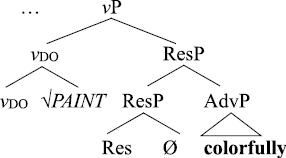
- ‘The artist painted colorfully.’
As ResP is structurally lower than the categorizer v in (12), the substructure up to ResP is not yet concerned with the verbal aspect, which is later determined as activity by vdo. In addition, a null theme is introduced as the complement of Res. This ensures that although there is no overtly pronounced object in (5), whatever is produced as a result of painting, even if it is not completed or cannot be delimited, is understood to be associated with colorfully.4
Before we delve into the topic of interest raised about (10), some discussion is in order on how the verbal root is introduced. We take the acategorial root √PAINT to head-adjoin to v in (11), following Marantz (2006), Levinson (2007; 2010; 2014), and Folli & Harley (2020). Aside from the particular flavor of v concerned, these scholars agree that with transitive verbs of creation, the verbal root serves as a manner modifier, identifying how the theme, the picture, is created—by painting. Levinson (2007; 2010; 2014) handles intransitive activity verbs in the same way. This is what we will assume about (11) and (12) for the moment.
However, as we unfold our discussion on manner and result roots (Rappaport Hovav & Levin 2010, Levin & Rappaport Hovav 2013, Beavers & Koontz-Garboden 2012, Mateu & Acedo-Matellán 2012, Acedo-Matellán & Mateu 2014, Folli & Harley 2020) in section 6, we will argue that the accomplishment structure (11) needs to be updated regarding the head-adjunction site for the root. Specifically, while the root √PAINT is a true manner modifier in the activity structure, as in (12), it is introduced via adjunction to Res, instead of v, in (11). As the predictions made by (11) throughout section 5 do not hinge on the locus of root adjunction, we focus on substantiating the parts of our proposal highlighted in (11)–(12).
Keeping this in view, we return to the two statements in (10). The current analysis provides an adequate explanation for this phenomenon. According to this proposal, resultative adverbs adjoin to ResP, in line with Geuder’s (2000) reasoning in (10a) that resultative adverbs are modifiers of results. The verbal aspect of an activity or accomplishment is concerned with a higher category vdo/cause, which simultaneously serves to verbalize the resulting structure. Nothing prevents an activity verb phrase from starting with a ResP constituent on its way up to v, as in (12).
Notably, the statement in (10b)—that an activity VP has no end point—does not entail that the event involves no creation of any sort. Something can be created as a result of the painting activity in (6a). It is just that the created result does not require the event of painting to be terminated.5 On the other hand, if the object of accomplishment VP is assumed to be incomplete, the sentence becomes felicitous, as in (13).
- (13)
- The artist painted the picture for two hours.
- Ok if: The picture is incomplete.
In brief, accomplishment VPs can accommodate an incomplete result. Likewise, activity VPs can accommodate some produced result, if the result does not terminate the event. Viewed this way, the representation in (12), where an activity VP contains a ResP, does not run afoul of (10b).
So far, we have established the key distinctions between activity and accomplishment VPs in (3) and (5). Let us now consider whether the representation (12) must be postulated for the entire class of activity verbs. In other words, is a silent ResP always present under vdo? The activity examples (8), repeated in (14), suggest not:
- (14)
- a.
- *The smith pounded thinly/finely.
- b.
- *Mary scrubbed cleanly.
- c.
- *The player kicked flat(ly).
The two subclasses of activity verbs exemplified by paintvi and poundvi differ in the semantic nature of verbal action. We propose that this is reflected in their syntactic structures. The verbal roots that qualify for insertion under the structure (12) are activity verbs with an understood object of creation. That is, they are intransitive members of verbs of creation (e.g., carve, cook, draw, inscribe, type, write) (Levin 1993, section 26).6 In contrast, the unacceptability of (14) shows that there is no reason to postulate a ResP in the syntactic structure involving verbal roots whose understood object, if any, is not the product of the verbal action. The structure of poundvi can thus be represented as in (15). With no ResP for the resultative adverbs to attach to, the sentences in (14) are unacceptable:7
- (15)
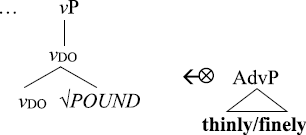
- *‘The smith pounded thinly/finely.’
To summarize, we have argued that resultative adverbs are modifiers adjoining to ResP. The ResP structure becomes a verb through composition with a higher functional element v, at which point aspectual information such as accomplishment (vcause) and activity (vdo) is also specified. The current proposal accounts for why resultative adverbs occur with the subclass of activity verbs naming creation in addition to accomplishment verbs. In the next section, we demonstrate that the contrasts between resultative adverbs and run-of-the-mill manner adverbs follow directly from this analysis.
4 Consequences: result vs. manner adverbs
According to the present proposal, resultative adverbs are ResP modifiers, as depicted in (11)–(12). Besides resultative adverbs, English possesses other types of adverbs marked with the -ly suffix. Among these, we are concerned with manner adverbs. Manner adverbs such as quickly and loudly describe the manner in which a verbal action is carried out.
- (16)
- The artist painted (the picture) quickly.
As manner adverbs scope over the verb—in (16), the painting action was quick—there is consensus that manner adverbs are associated with the verb phrase. Under the current set of assumptions then, manner adverbs are vP modifiers—that is, they are added after the structure is categorized as a verb.89
This, combined with the current findings on resultative adverbs, leads to the following conclusion:
- (17)
- Resultative adverbs are adjoined at a very early stage of derivation (i.e., ResP), whereas manner adverbs are adjoined relatively higher in the structure (i.e., vP).
In the rest of this section, we present three pieces of empirical evidence supporting (17): the syntactic distributions of manner and result adverbs (cf. Bowers 1993; Harley 1995), the patterns of ambiguous adverbs, and the behaviors of roots that derive into verbs and adjectives.
4.1 Syntactic distributions of resultative and manner adverbs
The consequence in (17) makes an immediate prediction about the syntactic distribution of resultative and manner adverbs. The structural order of the two types of adverbs that (17) yields is represented in (18):
- (18)
The syntactic hierarchy in (18) espouses the hypothesis that different types of adverbs are licensed by different syntactic heads (Travis 1988; Bowers 1993; Harley 1995; Cinque 1999; Alexiadou & Anagnostopoulou 2008). The novelty of (18) lies in its emphasis on a more elaborate verbal structure involving independent heads v and Res.
With the distinct attachment sites for resultative and manner adverbs, the structure (18) predicts that linearly, manner adverbs appear outside resultative adverbs. (19) and (20) support this prediction. When resultative and manner adverbs co-occur in a clause, resultative adverbs can appear closer to the verb, as in (19a) and (20a). However, switching the order of the adverbs, as in (19b) and (20b), significantly degrades grammaticality:10
- (19)
- a.
- The artist painted (the picture) colorfully (very) quickly.
- b.
- ???The artist painted (the picture) quickly (very) colorfully.
- (20)
- a.
- Carrie wrote (her signature) illegibly (very) quickly.
- b.
- ???Carrie wrote (her signature) quickly (very) illegibly.
The kind of ordering pattern in (19) and (20) was previously noted in Bowers (1993), followed by Harley (1995), as they attended to the distribution of “certain manner adverbs” in (21):
- (21)
- a.
- John learned French perfectly.
- b.
- Mary played the violin beautifully. (Bowers 1993: 606)
Bowers (1993) reports that two types of “manner adverbs” cannot change their positions, hence the contrast in (22):
- (22)
- a.
- John learned French perfectly (very) quickly.
- b.
- *John learned French quickly perfectly. (Bowers 1993: 607)
We think that the adverbs in (21), which Bowers (1993) originally analyzed as V adjuncts, are subsumed under Geuder’s (2000) resultative adverbs. Indeed, the adverbs in Bower’s examples do not express the manner of learning/playing. Rather, in (21a), the French learned is perfect. In (21b), what is created as a result of playing the violin is beautiful. The distributional restrictions in (22) are essentially those presented in (19)–(20). The contrast in (22) can thus be readily incorporated under the present account; it arises from the distinct attachment sites of resultative and manner adverbs.
4.2 Ambiguous adverbs
As observed by Geuder (2000) and Eckardt (2003), certain English adverbs can express either a result or manner interpretation. Adverbs such as beautifully and elegantly illustrate this, with the sentences in (23)–(24) being ambiguous.
- (23)
- The artist painted the picture beautifully.
- Result meaning: The picture produced as a result was beautiful.
- Manner meaning: The painting action was performed in a beautiful manner (True even when the picture created was not beautiful.)
- (24)
- Martha decorated the living room elegantly.
- Result meaning: The living room decorated was elegant.
- Manner meaning: Martha’s decorating action was performed in an elegant manner (True even when the living room decorated was not elegant.)
This class of ambiguous adverbs is expected to attach to either ResP or vP in (18), depending on whether a particular instance of the adverb is used to denote a result or manner. If so, these ambiguous adverbs should, in principle, be able to appear twice. When they do, the adverb that appears closer to the verb is expected to correspond to the resultative adverb, and, the outer one, to manner. This prediction is confirmed:
- (25)
- a.
- The artist painted the picture beautifullyRES beautifullyMAN.
- b.
- *The artist painted the picture beautifullyMAN beautifullyRES.
- (26)
- a.
- Martha decorated the living room elegantlyRES elegantlyMAN.
- b.
- *Martha decorated the living room elegantlyMAN elegantlyRES.
As marked by the subscript, (25a) and (26a) are acceptable with the understanding that the instance of beautifully and elegantly located adjacent to the verb expresses the result, while the following one refers to manner. By contrast, the unacceptability of (25b) and (26b) reveals that the inner adverb cannot refer to the manner with the outer one denoting the result.
4.3 Result roots and derivation into verb/adjective
The third empirical evidence for (17) involves a group of verbs and adjectives that are morphologically related. Before we delve into this topic, a discussion on “result roots” (Rappaport Hovav & Levin 2010; Levin & Rappaport Hovav 2013) is in order. Recall from the proposed structures in (11), (12), and (18) that ResP is introduced in the structure before turning into a verb by v. Within DM, the functional head a is also a categorizer. If so, nothing prevents a ResP from deriving as an adjective through composition with a. The verb and adjective containing a ResP substructure with v and a as the first categorizer would have the representations in (27) and (28), respectively. Here, (27) and (28) are identical except for the categorizing head with which ResP merges:
- (27)
- (28)
We propose that the structures in (27)–(28) are instantiated by a subset of English roots that derive either into a verb or an adjective (Myers 1984; Pylkkänen 2002; 2008; Embick 2004). The table in (29) illustrates these roots and their verb and adjective derivatives. A large portion of (29) is taken from Embick (2004: 358).
- (29)
- Roots deriving into verb/adjective
-
Root Verb Adjective √OPEN open open √CLOSE close closed √EMPTY empty empty √CLEAN clean clean √WARM warm warm √FLL fill full
We assume that the roots in (29) correspond to “result roots” in the sense of Rappaport Hovav & Levin (2010) and Levin & Rappaport Hovav (2013). Rappaport Hovav and Levin classify the verbal meaning of roots into two (and only two) sorts—manner and result. Verbs such as scrub and kick are derived from manner roots, which describe the manner of an action. In section 3, we tentatively aligned paint with the manner type, given its meaning pertinent to a manner of creation.11
According to Rappaport Hovav and Levin, the rest of the non-stative roots fall under the class of result roots, which name the result of the verbal event. These roots encode scalar changes and are systematically associated with gradable adjectives. The verbs in (29) fit this profile. Since roots in DM acquire the syntactic category through a higher functional category such as a or v, it stands to reason that the non-stative (verbal) and stative (adjectival) structures represented by the items in (29) derive from a single result root, as in (27)–(28).
Rappaport Hovav & Levin (2010) additionally propose that manner and result roots occupy different positions in the event structure. Mateu & Acedo-Matellán (2012), Acedo-Matellán & Mateu (2014), Alexiadou (2015), Alexiadou et al. (2015), and Folli & Harley (2020) embody this view syntactically by postulating distinct structural positions for manner and result roots. We follow the reasoning of Folli & Harley (2020) that result roots adjoin to Res, unlike v-adjoining manner roots. Hence, the internal structures of fill and full, for instance, considering (27) and (28), would be (30) and (31), respectively:12
- (30)
- (31)
In (30)–(31), the acategorial result root √FLL adjoins to Res, which projects as ResP. When ResP merges with v as in (30), it derives a verb and is spelled out as ‘fill’. In contrast, when ResP merges with a, as in (31), the root is categorized as an adjective and is realized as ‘full’.
With this in mind, the current analysis makes intriguing predictions about the behaviors of the result roots in (29). The ResP formed with these roots produces either a verb or an adjective, as in (30) and (31). If so, resultative adverbs should be able to occur in the adjective phrase, in addition to the verb phrase. This is because resultative adverbial adjunction takes place at the ResP. Crucially, this is before the categorizing head v or a is introduced into the structure, as in (32). Consequently, ResP should allow attachment of resultative adverbs, regardless of whether the ResP later composes with v or a.
- (32)
This prediction is confirmed. Resultative adverbs modify both the verb and adjective built upon result roots, as in (33)–(34):
- (33)
- a.
- Jim cleaned the room spotlessly.
- b.
- the spotlessly clean room
- (34)
- a.
- My aunt warmed the soup perfectly.
- b.
- the perfectly warm soup
Contrarily, manner adverbs are predicted to diverge from resultative adverbs in their ability to modify adjectives formed upon result roots as in (31). Unlike resultative adverbs, manner adverbs are attached to vP. This means that adverbs like quickly require the structure to project up to vP for adjunction to occur, as in (35). In contrast, since a pure adjective phrase like (36) lacks vP, it has no syntactic projection for manner adverbs to adjoin to.
- (35)
- (36)
The syntactic composition in (35)–(36) and the requirements of manner adverbs for vP make the following predictions. First, manner adverbs should be able to modify verbs derived from result roots (cf. (35)). Second, manner adverbs are not predicted to modify pure adjectives derived from result roots, which lack a verbal layer (cf. (36)). Both predictions are borne out:1314
- (37)
- a.
- Jim cleaned the room quickly.
- b.
- *the quickly clean room
- (38)
- a.
- My aunt warmed the soup quickly.
- b.
- *the quickly warm soup
The stark contrast in grammaticality between (37b)/(38b) and (33b)/(34b) is interesting. This is a natural consequence of the current set of proposals. Manner adverbs are incompatible with pure adjectives since they are adjoined to vP. In contrast, resultative adverbs, being ResP modifiers, can freely appear in the verb and adjective structures in which v and a select for ResP as the first categorizer.
The account simultaneously captures the acceptability of both resultative and manner modifications in (33a)/(34a) and (37a)/(38a). Both resultative and manner adverbial modifications are possible with verbs, but under distinct conditions—the former is licensed by ResP contained within vP, the latter by the vP.
In summary, the systematic contrasts between manner and resultative adverbs receive a principled account under the hypothesis that resultative adverbs attach to ResP. Specifically, it explains (i) the differing syntactic distributions of manner and result adverbs, (ii) the semantic conditions imposed on stacked, ambiguous adverbs, and (iii) the interaction between manner/resultative adverbs and the adjective/verb derivatives of result roots.
5 Extension: measure adverbs
Thus far, we have discussed the desirable consequences of treating resultative adverbs as ResP modifiers. In this section, we incorporate a subclass of adverbs called “measure adverbs” (Tenny 2000) into ResP modifiers. Measure adverbs express the degree of the state resulting from the verbal event, as in (39)–(40). Tenny observed that measure adverbs exhibit lexical variation in their preferred position relative to the verb. The measure adverbs in (39) come before the verb, while those in (40) come after the verb (Tenny 2000: 304):
- (39)
- a.
- Sylvia partly opened the door.
- b.
- Jeff mostly filled the beer glass.
- (40)
- a.
- Sylvia opened the door partway.
- b.
- Jeff filled the beer glass most of the way.
We propose that measure adverbs are adjoined to ResP, just as resultative adverbs. We follow Travis (1988) and Bowers (1993) in assuming that adverbs may either right-adjoin or left-adjoin to the head that licenses them. This means that pre-verbal adverbs (e.g., partly) and post-verbal adverbs (e.g., partway) differ in their adjunction side. If measure adverbs are a type of ResP modifiers, as we argue, then pre-verbal measure adverbs would adjoin to the left of ResP and post-verbal ones to the right of ResP, yielding (41) and (42), respectively:
- (41)
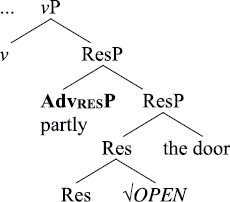
- ‘Sylvia partly opened the door.’
- (42)
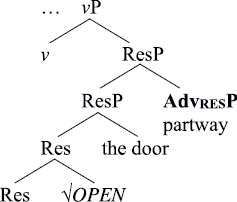
- ‘Sylvia opened the door partway.’
The analysis in (41)–(42) makes the following predictions. First, measure adverbs are expected to behave in parallel with resultative adverbs in terms of how they interact with manner adverbs. Second, measure adverbs, as with resultative adverbs, should be able to co-occur with adjective and verb derivatives of common roots. Below we show that both predictions are confirmed.
We first address the distributional patterns of measure adverbs in the presence of manner adverbs. Since manner adverbs are vP-adjoining, they are located higher than measure adverbs, irrespective of their position relative to the verb. The key predictions are thus as follows: (i) when a measure adverb and a manner adverb are attached on the same side, there should be a clear preference for the order in which the manner adverb appears outside the measure adverb; and (ii) when the measure and manner adverbs are attached on different sides, the two types of adverbs are expected to surround the verb and object sequence.
Because measure adverbs are divided into two types—pre-verbal and post-verbal, as in (41)–(42)—and manner adverbs can also appear pre-verbally (Travis 1988; Bowers 1993), we need to account for four combinations. Let us first examine pre-verbal measure adverbs. Under the current analysis, two syntactic representations result for pre-verbal measure adverbs, depending on whether the manner adverb quickly is right-adjoining (43) or left-adjoining (44).
- (43)
- (44)
The data below confirm the above predictions. As partly is left-adjoining and quickly is right-adjoining in (43), the ordering restriction is irrelevant. The structure (43) should thus yield grammatical (45a). In contrast, when quickly and partly both align on the left as in (44), quickly is expected to appear outside partly. Switching the linear order of the two adverbs should lead to degradation. This is borne out in (45b) and (45c).
- (45)
- a.
- Jill partly opened the door quickly.
- b.
- Jill quickly partly opened the door.
- c.
- ???Jill partly quickly opened the door.
Let us now consider post-verbal measure adverbs. Post-verbal measure adverbs such as partway right-adjoin to ResP. Again, two structures are relevant depending on whether quickly is right-adjoined (46) or left-adjoined (47):
- (46)
- (47)
This time we expect the ordering preference with (46), where both the measure and manner adverbs are aligned on the right. Partway, being attached to ResP, should sound natural before the vP-adjoining quickly. This prediction follows from the contrast in (48a) and (48b).15 Contrarily, since quickly and partway are adjoined on different sides in (47), the grammaticality of (48c) is expected.
- (48)
- a.
- Jill opened the door partway quickly.
- b.
- */?Jill opened the door quickly partway.
- c.
- Jill quickly opened the door partway.
The ordering patterns exhibited by manner and measure adverbs are expected under the present hypothesis. Measure adverbs are likely to appear inside manner adverbs when they are adjoined on the same side because measure adverbs are a kind of ResP modifier.
We now turn to an additional phenomenon where measure adverbs behave on par with resultative adverbs. Pylkkänen (2008: 111) notes that Tenny’s (2000: 304) measure adverbs can modify verbs (49) and pure adjectives (50) formed from a common root:16
- (49)
- a.
- Sylvia partly opened the door.
- b.
- Jeff mostly filled the glass.
- (50)
- a.
- the partly open door
- b.
- mostly full glasses of beer
The data in (49)–(50) corroborate the treatment of measure adverbs as ResP-attaching. Recall from section 4.3 that the underlined verbs and adjectives in (49) and (50) are derived from the result roots √OPEN and √FLL, respectively. Given this, the same arguments presented in section 4.3 apply to (49)–(50). Result roots √OPEN and √FLL project into ResP, at which point they are modified by measure, or resultative, adverbs, as argued earlier in (32). Afterwards, ResP turns into a verb if selected by v, or an adjective if selected by a. Therefore, we would expect measure adverbs to be able to modify both the verb and adjective derived from the same result root, as in (49) and (50).
A further prediction that directly follows is that the pure adjectives in (50) should not be modified by manner adverbs. This is confirmed:
- (51)
- a.
- *the quickly open door
- b.
- *quickly full glasses of beer
Thus far, we have shown that the parallel behaviors of measure and resultative adverbs are expected outcomes in an analysis in which they are both ResP modifiers. Before closing this section, it is interesting to observe the interaction of these two types of ResP adverbs. Specifically, as exemplified in (52)–(53), measure adverbs and resultative adverbs can co-occur in a sequence and freely switch linear positions within a clause:17
- (52)
- a.
- The artist painted the picture halfway colorfully.
- b.
- The artist painted the picture colorfully halfway.
- (53)
- a.
- Carrie wrote her signature partway illegibly.
- b.
- Carrie wrote her signature illegibly partway.
A reviewer remarks that the patterns we see in (52)–(53) are a surprise for the strictly restricted hypothesis about adverb licensing (cf. Cinque 1999). In such a view, one would not expect the same projection to allow the same type of adverbial twice. For this reason, one may cast doubt on the present proposal that both measure and resultative adverbs are licensed by Res. An alternative could be that the Res layer is further divided into two projections, each of which licenses measure and resultative adverbs.
However, this option faces an immediate challenge. This is because the interpretations of (52)–(53) reveal that the two types of adverbs can truly alternate in their order of syntactic adjunction. We illustrate this using (53). With comma intonation between the two adverbs, the two orders in (53) have the corresponding meanings in (54):
- (54)
- a.
- Carrie wrote her signature partway illegibly.
- Reads as: Carrie wrote part of her signature. Her signature written in part was illegible.
- b.
- Carrie wrote her signature illegibly partway.
- Reads as: Carrie’s writing of her signature illegibly is not finished.
As the interpretation of (54a) and (54b) basically refer to the same state of affairs in the real world, (54a) and (54b) are understood to have the same meaning.18
Crucially, the scope of the adverbs in (54) respects their linear order. Let us consider what this implies for the alternative above. If measure adverbs and resultative adverbs are licensed by different projections, say by Res1 and Res2 respectively, the data in (54) give rise to a contradiction within the hypothesis. Specifically, the linear orders in (54) and their corresponding interpretation motivate two representations, in which Res1 and Res2 structurally appear higher or lower with respect to each other. This, by itself, conflicts with the grand premise of the alternative hypothesis—namely, that the projections licensing different classes of adverbs display a strict syntactic hierarchy.
Given that the base-positions of adverbs are determined by their semantic scope (Andrews 1983, Cinque 1999), a reasonable explanation for the data in (52)–(54) is that measure and resultative adverbs can be structurally reordered. With this interim conclusion, the analogous patterns exhibited by measure adverbs and resultative adverbs, which are differentiated from manner adverbs, point to a less stringent theory of adverbial licensing. Therefore, we retain our proposal that measure and resultative adverbs are both modifiers of ResP. We conclude with Andrews (1983) that when measure and resultative adverbs co-occur, they form a “nested” ResP structure. However, ResP modifiers, as a group, are adjoined earlier in the structure than manner adverbs, as represented by the hierarchy in (18).
To summarize, the linear order between measure and manner adverbs and the ability of measure adverbs to modify the adjectives of result roots are congruent with the patterns of resultative adverbs. This array of facts points to the identical syntactic status of measure adverbs and resultative adverbs, namely, as modifiers of ResP. Meanwhile, measure and resultative adverbs can either precede or follow each other, with their semantic scope respecting the order of adjunction to ResP. This suggests that while adverb licensing takes place in a fixed hierarchy, the subtypes of adverbs associated with ResP may be authorized more than once in a constrained manner.
6 Manner vs. result roots
6.1 Final proposal: The loci for √PAINT insertion
In section 5, we extended the dissociative analysis of v and Res advanced in this study to measure adverbs (Tenny 2000). In this section, we examine novel data that lead us to revisit the locus of root adjunction. Specifically, we propose that some roots (e.g., √PAINT) can head-adjoin to either v or Res. The consequence is that depending on the syntactic location of these roots, the resulting verb either expresses a manner or result (Mateu & Acedo-Matellán 2012, Acedo-Matellán & Mateu 2014).
Note that the verbs in (55), previously (39), are derived from the result roots √OPEN and √FLL. Result roots are proposed to head-adjoin to Res as in (41), replicated in (56) below. Since the measure adverb is located higher than the verbal root, the representation in (56) returns the correct word order in (55a), where partly precedes the verb.19
- (55)
- a.
- Sylvia partly opened the door.
- b.
- Jeff mostly filled the beer glass.
- (56)
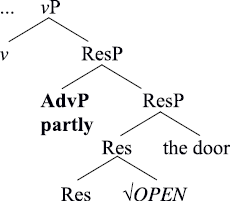
- ‘Sylvia partly opened the door.’
Let us now consider (57), where the measure adverb co-occurs with the transitive verb paint:
- (57)
- The artist partly painted the picture.
Because partly precedes the verb in (57), their relative order calls for a revisit of the accomplishment structure originally proposed in (11), regarding the syntactic head to which the verbal root adjoins.
We revise our initial structure in (11) as follows. Rather than adjoining to vcause, the verbal root √PAINT in the accomplishment event in (57) starts participating in the syntactic derivation early on. In particular, it attaches to Res, as in (58). The updated structure (58) correctly generates the sentence in (57):
- (58)
The revision made in (58) shows that √PAINT is inserted as a result root in the accomplishment structure, and the verb derived names a result (Rappaport Hovav & Levin 2010, Levin & Rappaport Hovav 2013), just like √OPEN and √FLL. This naturally directs us to re-evaluate the activity structure proposed in (12) in light of measure adverbial modification. In sharp contrast to (57), paint in its intransitive use cannot appear with pre-verbal measure adverbs:
- (59)
- *The artist partly painted.
The unacceptability of (59) leads us to retain our analysis in (12), repeated in (60). Otherwise, in an alternative structure in which √PAINT adjoins to Res instead of v in (60), one would expect the undesirable word order in (59), in which partly precedes the verb. Thus, we continue to propose that √PAINT derives a manner verb (Rappaport Hovav & Levin 2010, Levin & Rappaport Hovav 2013) in the activity structure.
- (60)
Further support for (60) is that the ungrammaticality of (59) is not simply due to the intransitivity of the predicate. As seen in (61), intransitive predicates expressing a change of state are perfectly acceptable with partly.
- (61)
- a.
- The door partly opened.
- b.
- The sky partly cleared.
The well-formedness of (61) is expected since the roots in (61) are attested to be the result type. In other words, they adjoin to Res in the substructure ResP depicted in (56). A difference between (61a) and (55a) is that the latter further composes with the external-argument-introducing head, developing into a transitive causative construction. The contrast in acceptability between (59) and (61) is thus compelling evidence that √PAINT manner-adjoins to vdo when used intransitively, as represented in (60).
Summarizing, we updated our preliminary analysis presented in section 3 regarding the position where the verbal root is head-adjoined, as in (62)–(63). The (im)possibility of modification by pre-verbal measure adverbs points to the conclusion that √PAINT occupies distinct syntactic positions, deriving into a result verb in the accomplishment structure and a manner verb in the activity structure.
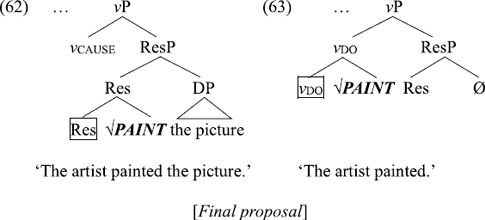
Two questions arise. First, the ungrammaticality of (59) is intriguing, given that resultative adverbs can modify activity verbs. We discussed this property of resultative adverbs at the outset of this study in (5), repeated here in (64):
- (64)
- The artist painted colorfully.
The contrast in grammaticality between (59) and (64) suggests that while both measure and resultative adverbs are attached to ResP, the two kinds of adverbs are subject to distinct syntactico-semantic conditions. Recall from section 3 that resultative adverbs adjoin to ResP which introduces a created result but the result need not be completed or delimited. In contrast, measure adverbs require the result to be measurable (Tenny 2000). In other words, there must be an element within the verb phrase that identifies the start and end of an event. This condition cannot be met in the activity verb phrase in (59), rendering it unacceptable. According to the proposal in (63), (59) is ruled out because √PAINT in activity events does not name a result but instead specifies the manner of verbal action.
Second, we have arrived at the conclusion that √PAINT is introduced via adjunction to distinct syntactic heads, Res and v, as in (62) and (63), based on the two constructions’ interaction with measure adverbs. As measure adverbs are part of what we aim to analyze in this study, our next step is to ask whether there is an independent motivation to treat √PAINT in (62) on par with attested result roots such as √FLL and √OPEN, while √PAINT in (63) with √SCRUB or √KICK. This question is addressed in the next subsection.
6.2 Truth-conditional diagnostics for manner/result
Rappaport Hovav & Levin’s (2010) dichotomy of manner/result verbs (stemming from Levin & Rappaport Hovav (1991) and Rappaport Hovav & Levin (1998)) has triggered a volume of investigations approached from different angles. Rappaport Hovav and Levin’s notion of manner/result is grounded in the assumption that a verbal “root” is a lexical semantic entity in the event structure that encodes meaning. Manner “roots” such as scrub and kick contain as part of their verb meaning the manner in which an action is carried out. In contrast, result “roots” like fill and open lexically encode the particular result of an event. They emphasize that no verb expressing a manner can also denote a result and that no verb expressing a result can also denote a manner—naming the generalization “manner/result complementarity.”
As Rappaport Hovav and Levin motivate manner/result complementarity, they use nonscalar/scalar changes to define manner/result verbs. Specifically, manner verbs are argued to be correlated with non-scalar changes, such that manner-denoting verbs do not entail a gradual change on a scale. For example, nothing about scrubbing or kicking entails a change in state or a change in motion toward a particular direction. In contrast, (non-stative) result verbs are associated with scalar changes. Thus, the degree of fullness or openness can be measured as the change proceeds toward the result named by the verbs fill and open.
Rappaport Hovav and Levin’s lexicalist notion of “manner/result roots” cannot be equated with the category-neutral, structural notion of roots used in syntactic approaches to the event structure. Crucially, since for Rappaport Hovav and Levin manner/result constitutes a verb’s core meaning, there is no reason for them to view transitive and intransitive paint independently. From this viewpoint, transitive and intransitive paint are the same lexical verb in different event structure templates. This premise is reflected in manner/result diagnostics based on lexical entailments (Rappaport Hovav 2008; Beavers & Koontz-Garboden 2012). Here, we illustrate this with two diagnostics. As we do so, we point out that a creation verb such as paint exhibits mixed behavior. Thereafter, we show that the apparently contradictory results of these two diagnostics can be made sense of if transitive and intransitive paint are not assumed to involve a single root. This supports our argument that when √PAINT surfaces in an activity VP, as in (63), the verb denotes manner.
First, according to Rappaport Hovav (2008:23) (as cited in Beavers & Koontz-Garboden (2012: 338–339)), verbs encoding a scalar change require an object that undergoes the change. Therefore, result verbs cannot be used intransitively with the theme argument deleted, as in (65). In contrast, manner verbs are not subject to this restriction. Thus, manner verbs allow the dropping of the theme argument, in which case they are unergative, as in (66):
- (65)
- a.
- Sylvia opened the door.
- b.
- *All last night, Sylvia opened.
- (66)
- a.
- Kim scrubbed the floor.
- b.
- All last night, Kim scrubbed. (Beavers & Koontz-Garboden 2012: 339)
Rappaport Hovav (2008) reasoned that the grammaticality of (66b) shows that scrub is a manner verb. That is, manner constitutes the central meaning of scrub regardless of whether it is used transitively (66a) or intransitively (66b).
Applying this diagnostic to paint gives the result that paint is a manner verb in Rappaport Hovav and Levin’s sense:
- (67)
- a.
- The artist painted the picture.
- b.
- All last night, the artist painted.
The second diagnostic probes the deniability of the result (Beavers 2008; 2011, Beavers & Koontz-Garboden 2012). Since result verbs entail a change in the theme argument, the change cannot be denied. As a consequence, a sentence containing a result verb cannot be followed by the clause nothing is different about X, wherein X refers to the theme/object of the verb being tested:
- (68)
- a.
- #Shayne just broke the vase, but nothing is different about it.
- b.
- #Shayne just shattered the bottle, but nothing is different about it. (Beavers & Koontz-Garboden 2012: 337)
Beavers (2011: 342) demonstrates that verbs of creation/consumption pattern like attested result verbs, as in (69). In other words, under this diagnostic, paint is a result verb.
- (69)
- #The artist painted the picture, but nothing is different about it.
Two aspects draw our attention. First, the result of this diagnostic is in contrast with the conclusion about (67). Second, notice that paint as an intransitive verb does not meet the condition for applying this test. This is because the intransitive counterpart of (69) contains no theme/object argument in the first clause which the pronoun in the second clause can co-refer to.20
The contradictory results of the above two diagnostics can be resolved under a hypothesis that transitive and intransitive paint may differ in whether they denote manner or result. Specifically, the fact that (67b) is acceptable shows that the structure represented by (67b) does not involve an argument that undergoes a scalar change. In other words, intransitive paint is a manner verb. On the contrary, the infelicity of (69) shows that transitive paint is a result verb whose object undergoes a change.
Under a framework in which roots receive interpretation according to the syntactic positions they are associated with (Borer 2003; 2005, Acquaviva 2009; Mateu & Acedo- Matellán 2012; Acedo-Matellán & Mateu 2014; Folli & Harley 2020), the above conclusion can be materialized with the structures in (70)–(71), repeated from (62)–(63). The category-neutral root √PAINT realizes a result verb/construction by being adjoined to Res, as in (70), while realizing a manner verb/construction by being base-generated in association with v, as in (71).21
- (70)
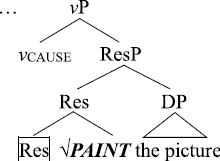
- ‘The artist painted the picture.’
- (71)
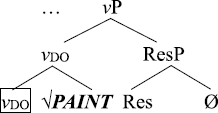
- ‘The artist painted.’
In summary, we have connected the results of some truth-conditional diagnostics for manner/result verbs to the proposal advanced in this paper. We have shown that the mixed behavior of paint is a consequence of a single acategorial root being associated with distinct positions in syntax.22 It joins the syntactic derivation at the level of v or Res, realizing a manner and result construction, respectively.
6.3 Measure adverbs as a diagnostic for result root
If the current proposal is on the right track, modifiability by measure adverbs (section 6.1) can serve as a test for result roots. Manner roots adjoin to vdo and pre-verbal measure adverbs such as partly do not appear with intransitive activity verbs. Result roots, on the other hand, can be modified by partly when they are later categorized as a verb/adjective. Put together, measure adverbs detect the presence of a result root in addition to the presence of a ResP layer.23
For the sake of adequacy, we reconnect our conclusions from this section to the group of activity verbs that do not accept resultative adverbial modification, as in (8)/(14). In section 3, we attributed this to the fact that the syntactic structure of poundvi lacks a ResP. No ResP means no result root. These verb phrases are thus expected to reject the partly modification. This prediction is confirmed in (73).
- (72)
- a.
- *The smith pounded thinly/finely.
- b.
- *The player kicked flat(ly).
- (73)
- a.
- *The smith partly pounded.
- b.
- *The player partly kicked.
Table (74) summarizes the findings on resultative and measure adverbs regarding the head-adjunction of manner and result roots.24 First, accomplishment verbs and a subset of activity verbs—namely, intransitive verbs of creation—contain a ResP and are thus compatible with resultative adverbial modification. Activity verbs that do not produce any result—and thus, with no silent ResP—are incompatible with resultative adverbs. Second, if a predicate can be additionally modified by measure adverbs, its syntactic structure involves a result root.25
| (74) Patterns of result and manner roots |
vcause (e.g., paintvt, openvt) |
vcause (e.g., openvi) |
vdo (e.g., paintvi) |
vdo (e.g., poundvi) |
| #1 Resultative adv. modification? | ✔ | ✔ | ✔ | * |
| #2 Measure adv. modification? | ✔ | ✔ | * | * |
| Result root (adjoined to Res) | Manner root (adjoined to v) | |||
7 Alternative hypotheses
Thus far, we have presented arguments in support of the following set of proposals.
P1: Aspectual information is encoded at the level of vP—vcause marking telic events and vdo atelic ones—whereas resultative adverbial modification occurs at the ResP.
P2: Measure adverbs (Tenny 2000) form a natural class with resultative adverbs in that they are both adjoined to ResP. Adverbs of results distinguish themselves from manner adverbs, which attach to vP.
P3: Measure adverbs not only target ResP but also require the (verbal) root to be within the ResP.
In this section, we review some alternative hypotheses. We reject some based on theory-internal issues and empirical setbacks (section 7.1). For others, we point out ways to accommodate the array of findings in their systems (section 7.2).
7.1 Verbal roots as a syntactic licensor of result adverbs
A reviewer suggests an alternative based on the diverging patterns of the two subtypes of the activity verb class in taking resultative adverbial modification. In sections 2–3, it was shown that a subgroup of activity verbs—namely, intransitive verbs of creation (e.g., carve, cook, draw, inscribe, paint, write)—is compatible with resultative adverbs. This is not possible with other activity verbs denoting a pure manner (e.g., pound, scrub, kick). The reviewer engages this with the possibility that the verbal root itself is responsible for the implicit result created by the former group of activity VPs. That is, the verbal root licenses the result. This calls into question the postulation of the ResP. Below we evaluate three analytical options that implement this idea syntactically. The conclusion is that while verb semantics is closely correlated with the modifiability of resultative adverbials (section 3), the syntactic projection that licenses adverbs of result cannot be the verbal root under the current set of assumptions.
First, (75) illustrates one way for a root to license the adverbs of results. In particular, it involves an activity structure with a manner root:
- (75)
Under the present framework, a manner root is head-adjoined to v (producing, e.g., paintvi). To maintain this premise, the root itself cannot be the locus of resultative adverbial attachment. The reasoning is as follows. If the root was to be the level to which the adverb adjoins, this amounts to saying that the root is a maximal, not a minimal, projection. The rootP under this scenario would be the complement of v, contradicting the assumption that manner roots are head-adjoined to v.
Next, to obviate the issue raised in (75), one could abandon the premise that roots are introduced via adjunction and instead posit that roots head their own maximal projection, as in (76) (e.g., Pylkkänen 2002; 2008). (76) enables us to postulate that adverbs of results are syntactically licensed by rootP, whereas manner adverbs are licensed by vP.
- (76)
However, (76) is not without a challenge. Here both manner and result roots are inserted under the bottom-most root position. Thus, by adopting (76) as it is, one must abandon the empirical advantages of introducing manner and result roots in distinct syntactic positions (Embick 2004; Mateu & Acedo-Matellán 2012; Acedo-Matellán & Mateu 2014; Alexiadou 2015; Alexiadou et al. 2015; Folli & Harley 2020, among others).26 To mitigate this loss, one may take a hybrid approach and hypothesize that manner roots are externally merged via head-adjunction, whereas result roots project a rootP downstairs. However, with this adjustment, the problem pointed out for (75) reemerges.
Finally, we could consider a simpler bipartite VP structure to flesh out the idea that verbal roots license resultative and measure adverbs:
- (77)
Note that in (77), it is the verbalized root that starts participating in the structure. Voice/v introduces an external argument. Here, both manner and result adverbs would attach to VP. This means that the structure says nothing about the preferred order between manner and result adverbs (sections 4.1–4.2 and section 5) or about the parallel patterns of verb/adjective derivatives (section 4.3 and section 5). (77) is not sufficiently elaborate to predict the observations made in this study.27
7.2 Existing analyses
The present study employs the extended notion of Res and the subcategorization of v to capture how adverbs of results interact with other elements within the verb phrase. Existing theories grounded in a different set of assumptions can accommodate the current findings, if they make some adjustments.
7.2.1 Acedo-Matellán and Mateu’s p
Acedo-Matellán & Mateu’s (2014) p is possibly the closest to the version of Res advocated in the present analysis. Their adpositional p head, as with Res, introduces result roots. A technical difference is that p takes an acategorial result root as its complement.
Dispensing with v flavors, Acedo-Matellán & Mateu (2014) propose that a syntactic representation may take a single p or double p projections below v. The number of p projection is correlated with telicity. Specifically, activity VPs accompany a single p layer, whereas accomplishment VPs an additional p layer on top of the lower pP.
To accommodate the current conclusion that (i) √PAINT is a manner root in the activity VP, while (ii) it is a result root in the accomplishment VP, an analysis espousing the p projections would be as in (78)–(79). (78) and (79) are based on Acedo-Matellán and Mateu’s dichotomy, “conflation” and “incorporation” (Haugen 2009):
- (78)
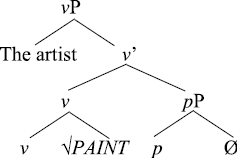
- ‘The artist painted.’
- (79)
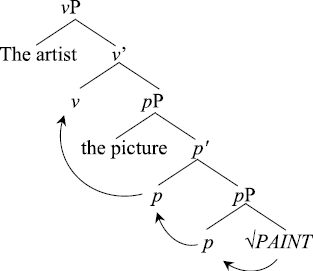
- ‘The artist painted the picture.’
In (78), the manner root √PAINT would be adjoined to v, through the process Acedo-Matellán and Mateu call “conflation.”28 With p taking the role equivalent to Res, a null pP needs to be posited. On the other hand, √PAINT is a result root in the accomplishment VP in (79). Thus, it is base-generated in the lower pP, similar to Acedo- Matellán and Mateu’s telic hammervt. The root then would “incorporate” to v, as with other result roots. The arrows indicate the trajectory of the movement.29
While Acedo-Matellán and Mateu style analysis can be extended as in (78)–(79), some questions are left for further contemplation. The verbal root in the accomplishment structure in (79) “incorporates” up to v. In section 6, we presented reasons to view measure adverbs as a modifier of the head introducing a result, which in (79) is p. However, if so, the movement of the result root to v in (79) and the attachment site for partly argued for in this study do not fully accord. Thus, it becomes a task to appropriately derive the word order between pre-verbal measure adverbs and accomplishment verbs.
7.2.2 Res(ult) and/or Proc(ess)
Ramchand (2008) represents aspectual classes with three essential syntactic heads—Init, Proc(ess), and Res. Notably, her original conception of Res only stands for identifiable, complete results. Therefore, the hierarchy of Proc selecting Res in the first phase ensures telic interpretation.
Further distinguishing the structures of manner and result verbs, Alexiadou (2015) and Alexiadou, Anagnostopoulou & Schäfer (2015) utilize the v and/or Result heads instead of v flavors. In particular, Alexiadou (2015) proposes that a causative structure (e.g., John opened the window) contains vProcess and a Result/result root, whereas an activity verb structure (e.g., John scrubbed (the floor)) simply takes vProcess, modified by a manner root.
In section 3, we proposed that what ResP introduces should include incomplete results as well. Because of this extension, the activity VP proposed in (12)/(63) consists of a vdo and ResP. In short, under our version of Res, the presence of ResP does not predict the telic aspect.
There are two key findings of this study that the above alternatives need to embrace. First, a functional projection needs to be reserved for a subclass of adverbs—adverbs of results, independent of v. Second, this projection is present in the activity structure of intransitive creation verbs.
For the above analyses to accommodate these conclusions, two possibilities can be suggested. One could opt to divide Res into two subcategories depending on whether the result it introduces is complete or incomplete. With this supplement, the activity and accomplishment structures of Ramchand (2008), Alexiadou (2015), and Alexiadou, Anagnostopoulou & Schäfer (2015) can simply take the appropriate subtype of Res. When Proc/vProcess selects for the sort of Res that denotes an incomplete result—say, ResINC—then it derives an activity VP. This activity VP accepts resultative adverbial modification. On the other hand, an accomplishment VP would consist of Proc/vProcess taking the other subcategory of Res as its complement—namely, the Res that denotes complete results.
Alternatively, if one adopts the extended implementation of Res, as we argue, such that Res can introduce various stages of results, then (a)telicity needs to come from somewhere else. The present account employs vdo and vcause. For other analyses that do not refer to v flavors, a separate head concerned with the verbal aspect is needed. There are several options to choose from in the literature. AspPQ (Borer 1994), FPDelimitation (Ritter & Rosen 1998), and the inner ASP set as [+definite] (Travis 2010), for instance, would serve this purpose. All correctly produce telic predicates when configured with Res and Proc/vProcess.
8 Result roots and Res
If the conclusions of this study are valid, an implication arises regarding the relationship between result roots and Res. The final proposal for creation verbs in (62)–(63), repeated below, distinguishes the syntactic status of the verbal root as result or manner:
- (80)
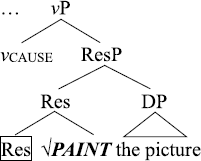
- ‘The artist painted the picture.’
- (81)
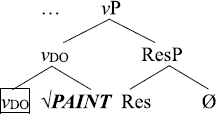
- ‘The artist painted.’
In section 7.1, we concluded that the verbal root layer cannot be responsible for resultative adverbial modification. This conclusion supports a stronger thesis—that a functional layer equivalent to Res must be postulated for structures involving result roots, as in (80). The reasoning for this is as follows.
In (81), the manner root joins the derivation through adjunction to v. Yet, the construction allows for resultative adverbs, as in (82). Crucially, since the verbal root is head-adjoined at the v level in (81), the syntactic level that accepts resultative adverbial modification cannot be the root/rootP for the reasons explicated in section 7.1. In addition, considering the contrasts between manner and resultative adverbs (section 4), there needs to be a syntactic layer, independent of v, that is in charge of resultative adverbial attachment. Resultative adverbs in the context of manner roots can thus be taken to adjoin at this layer, which we dub as ResP in (81).
- (82)
- a.
- The artist painted colorfully.
- b.
- Carrie wrote illegibly.
- c.
- Sylvia cooked exquisitely.
- d.
- Julie knitted intricately.
- e.
- The secretary transcribed messily.
Given that resultative adverbials are licensed by ResP in the manner construction in (81), it is reasonable to conclude that these adverbs also modify the same syntactic projection in the case of result construction in (80). In other words, there is no reason why the same subclass of adverbs is attached at ResP in the manner construction, while elsewhere in the result construction. It follows that ResP also needs to be posited in the context of result roots, as in (80).
A naturally ensuing question is: is a result root an adjunct to Res, as assumed in this study (Folli & Harley 2020) or is it a complement to Res along the lines of Rappaport Hovav and Levin (1998)? At this point, we are unable to offer a definitive answer. Instead, we narrow down the options for the latter, alternative assumption.
Two ways can be sought to materialize result roots as the complement of Res, as in (83)–(84). Of these, (83) does not provide a satisfactory explanation for the word order between the object and verbal root. Assuming that the result root stays in situ to accommodate the partly facts (sections 5–6), (83) as it stands is less preferable. This leaves (84) compatible with the current findings.
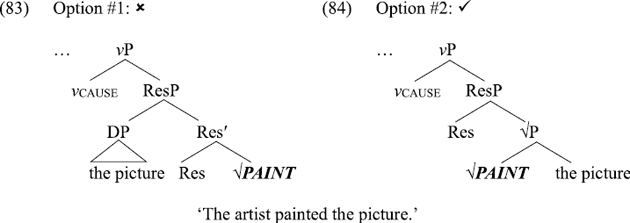
The results of this study allow for a more refined distinction between manner and result roots. Manner roots are introduced at the verbalizing level. Result roots are introduced by a lower functional projection.
9 Conclusions
The constellation of facts revolving around adverbs of results motivates a verbal structure in which the syntactic head licensing these adverbs (i.e., Res) and the head embodying the aspectual features of the verb (i.e., v) are separated. As a consequence, resultative adverbs can modify a subclass of activity verb phrases (section 3).
We ascribed various interrelated phenomena to the presence of ResP under the verbalizing layer. The proposal correctly predicts that resultative adverbs and measure adverbs behave similarly syntactically, distinguishing themselves from manner adverbs (sections 4–5). Manner adverbs, as vP modifiers, are located higher than resultative and measure adverbs, which are ResP modifiers. Therefore, the former group of adverbs appears outside the latter groups. In addition, only ResP modifiers can co-occur with both verbs and adjectives sharing a root. In so doing, we offered an explanation for the distributional restrictions imposed on ambiguous manner/result adverbs (e.g., beautifully).
We have also accounted for the contrasts between the two ResP modifiers (section 6). While both resultative and measure adverbs entail the presence of ResP, the two differ in their relationship with result roots. Measure adverbs require a syntactic structure where the acategorial root head-adjoins the Res head. In contrast, resultative adverbs are compatible with structures formed upon either result or manner roots, so long as the structure projects a ResP. The series of conclusions drawn in this study have led us to develop a new diagnostic for detecting result roots—namely, modifiability by measure adverbs.
The outcomes of this study corroborate earlier theories on the structural composition of verbs. First, the study provides support for a fine-grained configuration of verb phrases. In addition to Voice, v, and root, the head introducing a result—Res—requires a position in syntax. Moreover, the analysis is a modern syntactic incarnation of the idea that verbal roots are classified as manner or result (Levin & Rappaport Hovav 1991; 2013; Rappaport Hovav & Levin 1998; 2010). Roots enter syntax by way of adjunction (Levinson 2007; 2010). In particular, manner roots adjoin to v, whereas result roots adjoin to Res (Folli & Harley 2020).
As we seek an adequate account of the behaviors of adverbs of results, we have derived conclusions on closely related domains. We have revealed that verbs of creation are another class of verbs whose root (e.g., √PAINT) can either be associated with manner or result (Mateu & Acedo-Matellán 2012; Acedo-Matellán & Mateu 2014) (section 6). We have also shown that the appearance of resultative adverbs in the context of manner roots motivates Res to be present in the context of result roots (section 8).
To conclude, postulation of ResP independent of v is the key factor that runs through the wide range of observations investigated in this study. The systematicity of how ResP adverbs interplay with manner adverbs and manner/result roots discloses the syntactic nature of the phenomena.
Appendix: Adjectival resultatives
In this appendix, we discuss the impact that the conclusions of this study have on the structure of adjectival resultatives. As briefly discussed in (2b), the adjective in the adjectival resultative expresses a result. This semantic contribution of resultative adjectives contrasts with that of resultative adverbs, which Geuder (2000) identified as modifiers of results. The DP object in both (1) and (2) undergoes a change in state as the verbal event unfolds. The difference is that the object in (2) comes into existence, whereas in (1), it becomes red at the end of the event.
- (1)
- The artist painted [the fence red].
- (2)
- The artist painted [the picture].
A wealth of scrutiny has been conducted on the adjectival resultative construction in (1) (see Rothstein (2006) for an overview). From the point of interest at hand, it can be divided into two groups. More widely accepted is the approach in which the bracketed unit in (1) forms a small clause (Kayne 1984; Hoekstra 1988; Harley 2005; Kratzer 2005; among many others). This small clause is embedded in a matrix event named by the verb. Contrarily, there are the analyses wherein the adjective is part of a larger unit including the predicate paint (Williams 1980; Carrier and Randall 1992; Rothstein 1992; 2001). This approach implicitly views the adjective as some kind of adjunct, while syntactically positing a ternary node consisting of the verb, object and adjective phrase.
Marantz (2006) substantiated the latter perspective that the adjective phrase is an adjunct. He noted that the scope of the prefix re- in (3) ranges only over the DP object, excluding the adjective.
- (3)
- The artist re-painted the fence red.
- Ok with the situation: ‘The fence was previously painted in some other color.’
Marantz (2006) suggests that the adjective phrase is adverbial, being structurally located outside the constituent containing the predicate and object, as in (4). This would allow the adjective to be outside the scope of re-.
- (4)
- The artist [re-[painted the fence] red].
The conclusions of this study are in line with the structural composition in (4). The example in (5) shows that the structure of the adjectival resultative involves not only a ResP but also √PAINT as a result root.
- (5)
- The artist partly painted the fence red.
If the adjective phrase is an adjunct modifying the subevent as Marantz (2006) proposes, under the present analysis, the modified subevent would be the ResP consisting of the result root and the object. The aP realized as red would then be attached to this ResP to generate another ResP, as in (6).30
- (6)
It is notable that in (6), partly has two loci to attach—ResP1 and ResP2—although the two attachment options would produce a single word order in (5). This is desirable if we consider that (5) can describe the following two situations:
- (7)
- a.
- Situation A: ‘In the project of fence painting, painting part of it in red is finished.’
- b.
- Situation B: ‘The project of painting the fence in red is not finished.’
The low attachment of partly to ResP1 in (6) corresponds to the situation described in (7a). In this structural option red is outside the scope of partly. Thus, this indicates that the part painted is red. The rest of the fence could be either unpainted or painted in other color(s). The other attachment possibility is where partly scopes over the entire ResP2 in (6). In this option, the adjective red composes with the ResP1 prior to the composition of partly. This corresponds to the description in (7b), which entails that the part of the fence not painted in red remained unpainted. This implies that with the entire fence painted, the color would be red. Overall, while the adjunction ordering generates different situations, they have in common the red part of the fence, on which (7) converges.31
Note that the aP in (6) contains a root that qualifies as a result state, √RED. This means that the aP can contain a ResP on its own, as in (8):
- (8)
This predicts that the measure adverb should be able to modify the ResP in (8), correctly producing (9):
- (9)
- The artist painted the fence partly red.
Similarly, some expectations can be made using resultative adverbs. First, (10a) is an accomplishment structure with no resultative predicate. It involves a resultative adverb adjoined to the ResP containing the result root (cf. ResP1 in (6)), which is then directly selected by vcause. Second, if the resultative adverb is adjoined to the entire ResP2 in (6), (10b) is derived. Finally, with the aP structure containing a ResP of its own, as in (8), (10c) is also possible.32
- (10)
- a.
- The artist painted the fence beautifully.
- b.
- The artist painted the fence red beautifully.
- c.
- The artist painted the fence beautifully red.
To summarize, the present analysis of adverbs of results works in harmony with the idea that resultative secondary predicates are modifiers of a state resulting from a verbal event (Marantz 2006). At this point, let us reconsider Geuder’s (2000) emphasis that resultative adverbs do not name the resultant state themselves, whereas resultative adjectives do. Under the present account, Geuder’s insight can be reinterpreted based on the distinct structural properties of resultative adverbs and adjectives. In particular, resultative adjectives may contain a ResP, which may be modified by resultative adverbs. This gives the resultative adjective the status of secondary “predicate,” a characteristic shared with the primary predicate realized by the verbal root. To wit, a resultative adjective serves two roles simultaneously—as a modifier of a (primary) result and as a (secondary) result itself. On the contrary, the same cannot be said about resultative adverbs (or measure adverbs). Adverbs of results function as modifiers only and detail the resultant state expressed by verbal or (resultative) adjectival roots.33
Notes
- In Appendix, we come back to comment on what our proposal suggests for the structure of resultative adjectives like (2b). [^]
- Rappaport Hovav & Levin (2010), Beavers (2011), Rappaport Hovav (2014) distinguish between result XPs that correspond to an intended result (2b) and those that modify the result encoded by the verb (2a). [^]
- VoiceP above vP is assumed to host the external argument the artist. [^]
- A reviewer finds it circular that a (silent) ResP is present in (12) due to a resultative adverb and resultative adverbs are licensed because of a ResP. The use of the label “Res(ult)” as the syntactic locus of “resultative” adverbial attachment might give such an impression. The label of this functional category, however, is open to change. One may well borrow BE (Harley 1995), FIENT (Embick 2004), p (Acedo-Matellán & Mateu 2014) or even simply call it an FP. What we emphasize here is that there must be a functional category independent of the verbalizing, aspect-encoding head to which a subclass of adverbs are adjoined. If so, a correlation must exist between the presence of such a functional category and the licensing of resultative adverbs. Sections 4–5 present independent evidence for the postulation of ResP in (11)–(12). [^]
- The opposite is precisely the case with an accomplishment event like (4a). After the completion of the picture, the painting event cannot continue. [^]
- Verbs of consumption (e.g., eat, drink) pattern similarly with verbs of creation in that they can take an incremental object. While it is difficult to come up with appropriate resultative adverbs for these verbs, transitive verbs of consumption can appear with measure adverbs (Tenny 2000) (e.g., John partly/mostly ate the sandwich), which we also argue to be ResP modifiers in section 5. [^]
- We thank a reviewer for pointing out the contrast between paintvi and poundvi in resultative adverbial modification. In section 6.3, we present additional evidence for the structure of poundvi in (15) with regard to measure adverbs. [^]
- Manner adverbs are taken to be typical verb-related adverbials, distinguished from sentential adverbials such as fortunately and frankly (speaking) (Maienborn & Schäfer 2011). This classification is consistent with the view that manner adverbs are adjoined at vP, in contrast to C/TP. [^]
- Alexiadou & Anagnostopoulou (2008) also propose that manner adverbs are licensed by v based on Greek participles. However, this is not to be equated with our statement that manner adverbs are vP modifiers. Alexiadou & Anagnostopoulou (2008) view “result-oriented manner adverbs” in Greek (e.g., atsala ‘sloppily’) as manner adverbs requiring v. Under the present terms, this amounts to saying that resultative adverbs in Greek are attached to vP, in contrast to their English counterparts. Such distinct treatments are reasonable given the morphosyntactic differences between the resultative adverbs in Greek (Alexiadou & Anagnostopoulou 2008) and those in English (section 4.3 and fn.13). [^]
- One of our consultants was less resistant to (19b) and (20b). We speculate that the effect of the misplaced adverbs in (19b)/(20b) share its root with the degradation caused by attributive adjectives not arranged in the normal order (e.g., young black-haired Turkish girls). The degree of aversion to (19b)/(20b) is thus difficult to measure and may be subject to some speaker-variation. Importantly, however, the same consultant found (19a) and (20a) impeccable. We take the unanimously clear preference for (19a)/(20a) over (19b)/(20b) to be supportive of the hierarchy proposed in (18). The judgements reported in Bowers (1993) on (21)–(22) also align with this conclusion. [^]
- Rappaport Hovav and Levin’s definition of manner based on nonscalar changes presents an interesting question for paint-type verbs. We return to this topic in section 6. [^]
- One may assume that the incremental theme (e.g., glass) is in the complement of Res, which is omitted in (30)–(31). Given the word order within the noun phrase, the theme in (30) is assumed to be a full-fledged DP while that in (31) is an nP. Alternatively, one could posit that Res in both (30)–(31) takes a DP complement and that the D in (31) undergoes movement above a. [^]
- Notice that in contrast to (37b) and (38b), deverbal adjectives in (i)–(ii) allow manner modification. This follows naturally if one adopts Embick’s (2004) conclusion that these adjectives contain a vP layer below the aP level. In other words, the adjectives in (i)–(ii) take v as the first categorizer and are later adjectivized. We thank a reviewer for this discussion and providing the examples.
- (i)
- a.
- the quickly cleaned room
- b.
- the quickly warmed soup
- (ii)
- a.
- The quickly cleaned facade from the graffiti will discourage the graffiti vandals from attacking the building again
[^]- b.
- … and tapped the quickly warmed head-water jacket coolant that was getting first warmth …
- While the patterns observed in (37b)/(38b) and (i)–(ii) in fn. 13 are accounted for under the proposal advanced here, a series of considerations revolving them raise a new question of whether Res(ult) is actually an appropriate name for denoting the state expressed by pure adjectives in (33b)/(34b). This is because pure adjectives can be a state resulting from a prior event but not necessarily. Thus, one needs to take into account that “Res” and “result roots” used in this study have broader empirical coverage than how they are used in practice. Alternatively, a more general concept equivalent to Res (e.g., BE in Harley (1995) or p in Acedo-Matellán & Mateu 2014) may obviate this issue. [^]
- Our consultants diverged in whether they fully reject (48b) or not. For reasons explicated in fn. 10, we draw attention to the evident preference for the orders in (48a) and (48c), which is what the syntactic hierarchy in (18) predicts. [^]
- Pylkkänen (2002; 2008) takes this as evidence that measure adverbs are root-modifiers. This position was later endorsed by Levinson (2014). See section 7.1 for arguments against this alternative. [^]
- Because resultative adverbs tend to follow the verb-object sequence (cf. Bowers 1993), we focus on the interaction with post-verbal measure adverbs here. [^]
- Notice that (54a) is syntactically ambiguous. Without a comma intonation between the two adverbs, (54a) has an additional meaning that ‘Carrie wrote her signature. Her signature is part illegible and part legible’. This would originate from the other structure of (54a), where partway modifies illegibly, forming a complex AdvP. What is at issue here is that (54a) has the meaning wherein illegibly modifies the syntactic constituent marked by the comma intonation. This reflects the verbal (i.e., ResP) attachment of the inner adverb, to which the outer adverb is adjoined. [^]
- This necessitates the assumption that the root stays in its base position in syntax and that the tense morphology attaches to the verb via a kind of morphological merger (Bobaljik 1994). [^]
- Beavers & Koontz-Garboden (2012) test unergatives using a personal pronoun co-referring to the subject (i), to reaffirm that they are manner verbs. We do not think that applying this test to pure unergatives achieves what it is originally devised to test. However, if the felicity of (i) suggests that yell is a manner verb, then the felicity of (ii) can be understood to mean that intransitive paint is a manner verb, in contrast to transitive paint in (69).
- (i)
- Bob just yelled, but nothing is different about him. (Beavers & Koontz-Garboden 2012: 337)
A reviewer also points out that (iii) is infelicitous, suggesting that (intransitive) paint is a result verb.- (ii)
- The artist painted but nothing is different about him.
However, to ensure the generality of the test, we use nothing is different about X as the following clause, as with Beavers (2011) and Beavers & Koontz-Garboden (2012). In fact, considering (ii) along with (67) and other lexical entailment diagnostics developed in Beavers & Koontz-Garboden (2012), paint (as a single lexical semantic “root”) is more likely to be diagnosed as manner. For this conclusion, (69) remains as a question. See fn. 22. [^]- (iii)
- #The artist painted (colorfully), but the canvas remained blank.
- Mateu & Acedo-Matellán (2012) and Acedo-Matellán & Mateu (2014) have reached the same conclusion about √BREAK. See Yu et al. (2023) for a diverging view that √BREAK is a result root lexico-semantically but appears either as v-modifier or below v in syntax. [^]
- As a reviewer points out, the ontological approach to roots (Rappaport Hovav & Levin 2010, Levin & Rappaport Hovav 2013) would appeal to root polysemy to explain the set of facts concerning paintvt and paintvi. [^]
- Note that the measure adverbial test is to be taken as a sufficient condition for result roots. For example, kill is a causative predicate and possibly involves a result root. However, the binary values associated with the result encoded in kill (i.e., ±dead) are at odds with partly (e.g., #They partly killed the mosquito. vs. They partly destroyed the city.). [^]
- We classify unaccusative change-of-state predicates as vcause along the lines of Alexiadou et al. (2006). [^]
- One may question whether the v flavors are needed after all, since the two structures of paintvt and paintvi can be distinguished with the adjunction sites of the root. Considering the broader inventory of verb classes, however, we think that subcategorization of v is still needed. This is because a verb class is likely to exist with the structural combination of a manner root and vcause (e.g., give). We leave open the specifics of this pursuit. [^]
- One could also point out that as category-less units, roots in DM are not expected to be modified by adverbs. See also Borer (2005; 2013; 2014), van Craenenbroeck (2014), Acedo-Matellàn & Mateu (2014), and De Belder & van Craenenbroeck (2015) for the more stringent arguments that roots, as a syntactic primitive, cannot take an internal argument. Thus, (76) is conceptually less preferable if there is an alternative free of these concerns with the same empirical coverage. [^]
- Another alternative to (77) comprised of √P and external-argument-hosting vP (Marantz 1997) still faces the questions posed for (76). [^]
- (78) does not violate Mateu & Acedo-Matellán (2012) and Acedo-Matellán & Mateu’s (2014) core proposal that conflation and incorporation cannot take place simultaneously since the pP does not contain the root element. [^]
- This means both intransitive and transitive creation verb structures in Acedo-Matellán and Mateu (2014) call for reconsideration. In their proposal, transitive creation verbs like bake—the counterpart of (79)—involve a manner root, “conflated” to v. Meanwhile, with unergative creation verbs—equivalent to (78), the root (e.g., √DANCE) base-generates as a complement to v, underdoing “incorporation”. [^]
- The structure in (6) captures Marantz’s observation that re- may target a result state that is not described by the adjective. The result state expressed by ResP1 in (6) is restored under the reading in (3). [^]
- This understanding of (7) in relation to the structure (6) is consistent with what we observed about the interaction between two ResP adverbs in section 5. In the example (54) of the article, the alternating orders of illegibly and partway produce the same end result with respect to the part written being illegible. [^]
- The adjunct account of resultative secondary predicates predicts that (10c) can also be produced by attaching beautifully to the verbal spine of inner ResP (i.e., ResP1 in (6)). The prominent meaning of (10c) is one in which the red color is beautiful, although it significantly overlaps with the meaning calculated from the above structural option. That is, it is difficult to think of a situation in which the fence is beautifully painted but its color is not beautiful. We take this to mean that attaching a resultative adverb to the verbal ResP1 prior to composition with aP in (6) is possible. Given that the resultative predicate can also take the form of a PP, the corpus data retrieved from COCA below are also in line with this conclusion:
- (i)
- Kent Myers weaves these diverse characters together beautifully [into his strong narrative]. (SPOK)
[^]- (ii)
- I was thankful for the children who were (…) growing up beautifully [into people that I would want to be with]. (WEB)
- Given that a majority of resultative adverbs are deadjectival (e.g., beautiful-ly, illegibl-y), the strong version of this statement would analyze the modification of a resultative adverb by a measure adverb in fn. 18 of the article as [Adv [Adj partway illegibl]-y] rather than [Adv partway [Adv illegibly]]. Besides the (in)ability to detect result roots, the impossibility for illegibly to modify partway shows that the resultative and measure adverbs do have some qualitative differences. [^]
Acknowledgements
The unsourced data in this article were collected through consultation with a small number of native speakers. An earlier version of this work was presented at the 2022 winter conference of the Korean Association of Language Sciences (KALS). We would like to express our gratitude to the editor Johan Rooryck and the three anonymous reviewers, whose insightful comments greatly improved the quality of this paper, as well as the audiences of KALS. We thank Sara Peterson, Heidi Harley, Jeff Punske, Sylvia Reed, and colleagues in General Education at Silla University for sharing their judgments. Special thanks to Sara Peterson for her guidance and feedback throughout the research process as our primary consultant.
Competing interests
The authors have no competing interests to declare.
References
Acedo-Matellán, Víctor & Mateu, Jaume. 2014. From syntax to roots: a syntactic approach to root interpretation. Alexiadou, Artemis & Hagit Borer, Hagit & Schäfer, Florian (eds.), The syntax of roots and the roots of syntax, 14–32. Oxford: Oxford University Press. DOI: http://doi.org/10.1093/acprof:oso/9780199665266.003.0002
Acquaviva, Paolo. 2009. Roots and lexicality in Distributed Morphology. York Papers in Linguistics Series 2 10. 1–21.
Alexiadou, Artemis. 2015. The causative alternation revisited: constraints and variation. English Linguistics 32(1). 1–21. DOI: http://doi.org/10.9793/elsj.32.1_1
Alexiadou, Artemis & Anagnostopoulou, Elena & Schäfer, Florian. 2006. The properties of anticausatives cross-linguistically. In Frascarelli, Mara (ed.), Phases of interpretation, 187–212. Berlin: Mouton de Gruyter. DOI: http://doi.org/10.1093/acprof:oso/9780199571949.001.0001
Alexiadou, Artemis & Anagnostopoulou, Elena & Schäfer, Florian. 2015. External arguments in transitivity alternations: a layering approach. Oxford: Oxford University Press.
Alexiadou, Artemis & Anagnostopoulou, Elena. 2008. Structuring participles. In Chang, Charles B. & Haynie, Hannah J. (eds.), Proceedings of the 26th West Coast Conference on Formal Linguistics, 33–41. Somerville, MA: Cascadilla Proceedings Project.
Andrews, Avery. 1983. A Note on the constituent structure of modifiers. Linguistic Inquiry 14(4). 695–697.
Arad, Maya. 2005. Roots and patterns: Hebrew morpho-syntax. Dordrecht: Springer.
Beavers, John. 2008. Scalar complexity and the structure of events. In Event structures in linguistic form and interpretation, Dölling, Johannes & Heyde-Zybatow, Tatjana & Schäfer, Martin (eds.), 245–265. Berlin: Mouton de Gruyter. DOI: http://doi.org/10.1515/9783110925449.245
Beavers, John. 2011. On affectedness. Natural Language and Linguistic Theory 29. 335–370. DOI: http://doi.org/10.1007/s11049-011-9124-6
Beavers, John & Koontz-Garboden, Andrew. 2012. Manner and result in the roots of verbal meaning. Linguistic Inquiry 43(3). 331–369. DOI: http://doi.org/10.1162/LING_a_00093
Bobaljik, Joanathan. 1994. What does adjacency do. In Harley, Heidi & Phillips, Colin (eds.), MIT working papers in linguistics 22: The morphology-syntax connection, 1–32.
Borer, Hagit. 1994. The projection of arguments. In Benedicto, Elena & Runner, Jeffrey (eds.), Functional projections, 19–47. University of Massachusetts Occasional Papers in Linguistics 17. Amherst: University of Massachusetts, Graduate Linguistic Student Association.
Borer, Hagit. 2003. Exo-skeletal vs. endo-skeletal explanations: syntactic projects and the lexicon. In Moore, John & Polinsky, Maria (eds.), The nature of explanation in linguistic theory, 31–67. Standford: CSLI Publications.
Borer, Hagit. 2005. In name only: structuring sense I. Oxford: Oxford University Press. DOI: http://doi.org/10.1093/acprof:oso/9780199263905.001.0001
Borer, Hagit. 2013. Taking form: Structuring sense III. Oxford: Oxford University Press. DOI: http://doi.org/10.1093/acprof:oso/9780199263936.003.0009
Borer, Hagit. 2014. Wherefore roots? Theoretical Linguistics 40(3/4). 343–359. DOI: http://doi.org/10.1515/tl-2014-0016
Bowers, John. 1993. The syntax of predication. Linguistic Inquiry 24(4). 591–656.
Carrier, Jill & Randall, Janet. 1992. The argument structure and syntactic structure of resultatives. Linguistic Inquiry 23. 173–234.
Cinque, Guglielmo. 1999. Adverbs and functional heads: a cross-linguistic perspective. New York/Oxford: Oxford University Press.
Cuervo, María Cristina. 2003. Datives at large. Cambridge, Mass: MIT dissertation.
De Belder, Marijke & van Craenenbroeck, Jeroen. 2015. How to merge a root. Linguistic Inquiry 46(4). 625–655. DOI: http://doi.org/10.1162/LING_a_00196
Dik, Simon. 1975. The semantic representation of manner adverbials. In Kraak, Albert (ed.), Linguistics in the Netherlands 1972–1973, 96–121. Amsterdam: Van Gorcum.
Dowty, David. 1979. Word meaning and Montague grammar. Number 7 in Synthese Language Library. Dordrecht: Reidel. DOI: http://doi.org/10.1007/978-94-009-9473-7
Eckardt, Regine. 1998. Adverbs, events, and other things: Issues in the semantics of manner adverbs. Tübingen: Max Niemeyer Verlag. DOI: http://doi.org/10.1515/9783110913781
Eckardt, Regine. 2003. Manner adverbs and information structure: evidence from the adverbial modification of verbs of creation. In Lang, Ewald & Maienborn, Claudia & Fabricius-Hansen, Cathrine. (eds.), Modifying Adjuncts, 261–306. Berlin: Mouton de Gruyter. DOI: http://doi.org/10.1515/9783110894646.261
Embick, David. 2004. On the structure of resultative participles in English. Linguistic Inquiry 35(3). 355–392. DOI: http://doi.org/10.1162/0024389041402634
Folli, Raffaella & Harley, Heidi. 2005. Consuming results in Italian and English: flavors of v. In Kempchinsky, Paula & Slabakova, Roumyana. (eds.), Aspectual inquiries, 95–120. Dordrecht: Springer. DOI: http://doi.org/10.1007/1-4020-3033-9_5
Folli, Raffaella & Harley, Heidi. 2007. Causation, obligation and argument structure: On the nature of little v. Linguistic Inquiry 38(2). 197–238. DOI: http://doi.org/10.1162/ling.2007.38.2.197
Folli, Raffaella & Harley, Heidi. 2020. A head movement approach to Talmy’s typology. Linguistic Inquiry 51(3). 425–470. DOI: http://doi.org/10.1162/ling_a_00351
Geuder, Wilhem. 2000. Oriented adverbs. Tübingen, Baden-Württemberg: Tübingen University dissertation.
Halle, Morris & Marantz, Alec. 1993. Distributed morphology and the pieces of inflection. In Hale, Ken & Keyser, Samuel Jay (eds.), The view from building 20, 111–176. Cambridge: MIT Press.
Harley, Harley. 1995. Subjects, events and licensing. Cambridge, Mass: MIT dissertation.
Harley, Heidi. 2005. How do verbs get their names? Denominal verbs, manner incorporation, and the ontology f verb roots in English. In Erteschik-Shir, Nomi & Rapoport, Tova (eds.), The syntax of aspect, 42–64. Oxford: Oxford University Press. DOI: http://doi.org/10.1093/acprof:oso/9780199280445.003.0003
Harley, Harley. 2009. The morphology of nominalizations and the syntax of vP. In Giannakidou, Anastasia & Monika, Rathert (eds.), Quantification, definiteness, and nominalization, 320–342. Oxford: Oxford University Press.
Harley, Harley. 2013. External arguments and the Mirror Principle: On the independence of Voice and v. Lingua 28, 34–57. DOI: http://doi.org/10.1016/j.lingua.2012.09.010
Harley, Harley & Noyer, Rolf. 2000. Formal versus encyclopedic properties of vocabulary: evidence from nominalisations. In Peeters, Bert (ed.), The lexicon-encyclopedia interface, 349–384. Oxford: Elsevier. DOI: http://doi.org/10.1163/9780585474465_014
Haugen, Jason D. 2009. Hyponymous objects and late insertion. Lingua 119. 242–262. DOI: http://doi.org/10.1016/j.lingua.2007.10.008
Hoekstra, Teun. 1988. Small clause results. Lingua 74. 101–139. DOI: http://doi.org/10.1016/0024-3841(88)90056-3
Kayne, Richard. 1984. Connectedness and binary branching. Dordrecht: Foris. DOI: http://doi.org/10.1515/9783111682228
Kratzer, Angelika. 1996. Severing the external argument from its verb. In Rooryck, Johan & Zaring, Laurie (eds.), Phrase structure and the lexicon, 109–137. Dordrecht: Kluwer. DOI: http://doi.org/10.1007/978-94-015-8617-7_5
Kratzer, Angelika. 2005. Building resultatives. In Maienborn, Claudia & Wöllenstein-Leisten, Angelika (eds.), Event arguments in syntax, semantics, and discourse, 177–212. Tübingen: Niemeyer. DOI: http://doi.org/10.1515/9783110913798.177
Levin, Beth. 1993. English verb classes and alternations: a preliminary investigation. Chicago/London: The University of Chicago Press.
Levin, Beth & Rappaport Hovav, Malka. 1991. Wiping the slate clean: A lexical semantic exploration. Cognition 41. 123–151. DOI: http://doi.org/10.1016/0010-0277(91)90034-2
Levin, Beth & Rappaport Hovav, Malka. 2013. Lexicalized meaning and manner/result complementarity. In Arsenijević, Boban & Gehrke, Berit & Marín, Rafel (eds.), Subatomic semantics of event predicates, 49–70. Springer: Dordrecht. DOI: http://doi.org/10.1007/978-94-007-5983-1_3
Levinson, Lisa. 2007. The roots of verbs. New York City, New York: New York University dissertation.
Levinson, Lisa. 2010. Arguments for pseudo-resultative predicates. Natural Language and Linguistic Theory 28(1). 135–182. DOI: http://doi.org/10.1007/s11049-010-9089-x
Levinson, Lisa. 2014. The ontology of roots and verbs. In Alexiadou, Artemis & Borer, Hagit & Schäfer, Florian (eds.), The syntax of roots and the roots of syntax, 208–229. Oxford: Oxford University Press. DOI: http://doi.org/10.1093/acprof:oso/9780199665266.003.0010
Maienborn, Claudia & Schäfer, Martin. 2011. Adverbs and adverbials. In Maienborn, Claudia & von Heusinger, Klaus & Portner, Paul (eds.), Semantics. an international handbook of natural language meaning volume 1. (HSK Handbook series), 1390–1419. Berlin/New York: Mouton de Gruyter.
Marantz, Alec. 1997. No escape from syntax: don’t try morphological analysis in the privacy of your own lexicon. Penn working papers in linguistics 4. 201–225.
Marantz, Alec. 2006. Argument structure and morphology: noun phrases that name events. Handout. New York University.
Mateu, Jaume & Acedo-Matellán, Victor. 2012. The manner/result complementarity revisited: a syntactic approach. In Cuervo, María Cristina & Roberge, Yves (eds.), The end of argument structure, 209–228. Bingley, UK: Emerald Books. DOI: http://doi.org/10.1163/9781780523774_010
Myers, Scott. 1984. Zero-derivation and inflection. MIT working papers in linguistics 7. 53–69.
Piñón, Christopher. 2008. (il)legibly. Handout from a talk presented at Ereignissemantik-Workshop, IDS, Mannheim. Dec. 12th, 2008.
Pylkkänen, Liina. 2002. Introducing arguments. Cambridge, Mass: MIT dissertation.
Pylkkänen, Liina. 2008. Introducing arguments. Cambridge, Mass: MIT Press. DOI: http://doi.org/10.7551/mitpress/9780262162548.001.0001
Ramchand, Gillian. 2008. Verb meaning and the lexicon. Cambridge: Cambridge University Press. DOI: http://doi.org/10.1017/CBO9780511486319
Rappaport Hovav, Malka. 2008. Lexicalized meaning and the internal structure of events. In Rothstein, Susan (ed.), Theoretical and crosslinguistic approaches to the semantics of aspect, 13–42. Amsterdam: John Benjamins. DOI: http://doi.org/10.1075/la.110.03hov
Rappaport Hovav, Malka. 2014. Building scalar changes. In Alexiadou, Artemis & Hagit Borer & Schäfer, Florian (eds.), The syntax of roots and the roots of syntax, 259–281. Oxford: Oxford University Press. DOI: http://doi.org/10.1093/acprof:oso/9780199665266.003.0012
Rappaport Hovav, Malka & Levin, Beth. 1998. Building verb meanings. In Butt, Miriam & Geuder, Wilhelm (eds.), The projection of arguments: lexical and compositional factors, 97–134. Stanford, CA: CSLI Publications.
Rappaport Hovav, Malka & Levin, Beth. 2010. Reflections on manner/result complementarity. In Rappaport Hovav, Malka & Doron, Doron & Sichel, Ivy (eds.), Lexical semantics, syntax, and event structure, 21–38. Oxford: Oxford University Press. DOI: http://doi.org/10.1093/acprof:oso/9780199544325.003.0002
Ritter, Elisabeth, & Rosen, Sarah. 1998. Delimiting events in syntax. In Butt, Miriam & Geuder, Wilhelm (eds.), The projection of arguments: lexical and compositional factors, 135–164. Stanford, CA: CSLI Publications.
Rothstein, Susan. 1992. Case and NP licensing. Natural Language and Linguistic Theory 10. 119–139. DOI: http://doi.org/10.1007/BF00135360
Rothstein, Susan. 2001. Predicates and their subjects. Dordrecht: Kluwer.
Rothstein, Susan. 2006. Secondary predication. In Everaert, Martin & van Riemsdijk, Henk (eds.), The blackwell companion to syntax volume I, 209–233. Blackwell Publishing. DOI: http://doi.org/10.1002/9780470996591.ch58
Schäfer, Martin. 2005. German adverbial adjectives: syntactic position and semantic interpretation. Leipzig, Saxony: Universität Leipzig dissertation.
Tenny, Carol. 2000. Core events and adverbial modification. In Tenny, Carol & Pustejovsky, James (eds.), Events as grammatical objects: the converging perspectives of lexical semantics and syntax, 285–334. Stanford, CA: CSLI Publications.
Travis, Lisa. 1988. The syntax of adverbs. McGill Workinq Papers in Linauistics: Proceedings of the Comparative Germanic Syntax 20. 280–310.
Travis, Lisa. 2010. Inner aspect: the articulation of VP. Dordrecht Heidelberg London New York: Springer.
van Craenenbroeck, Jeroen. 2014. On diagnosing complement-taking roots. Theoretical Linguistics 40(3/4). 361–373. DOI: http://doi.org/10.1515/tl-2014-0017
Vendler, Zeno. 1967. Causal relations. The Journal of Philosophy 64(21). 704–713. DOI: http://doi.org/10.2307/2023854
Williams, Edwin. 1980. Predication. Linguistic Inquiry 11. 203–238.
Yu, Jianrong & Ausensi, Josep & W. Smith, Ryan. 2023. States and changes-of-state in the semantics of result roots: Evidence from resultative constructions. Natural Language and Linguistic Theory. DOI: http://doi.org/10.1007/s11049-023-09570-9

